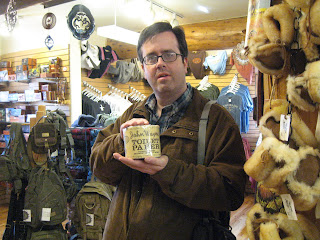As soon as the half-stoned teenager assaults you for the $9.75 entrance fee (per person!), you are led to a rapidly filling parking lot where, in the distance, the ruins call as if brought here from Disneyland. Ain't they something? One wonders how many people think these plastic reproductions are the real deal, but I'm sure I'd be depressed by the results. When considering vacation options, Colorado families likely look at a map, get frustrated by the long drive to Mesa Verde, and figure that these dwellings are, well, just as good. And you sure as hell can't get a greasy burger at those snooty NPS sites, can you? The teepee was a nice touch, too, reminding everyone involved that Anasazi, though a hard word to pronounce, is some sort of Indian, and no one who comes here is likely to care about tribal distinctions.
As you close in on the circus of stone and plaster, the piped-in music dazzles the ear with its stereotypical silliness. That it's the exact same music one hears at The Fort restaurant in Morrison, CO shouldn't matter, but all I could think of was the delicious quail that would not be found at this attraction's buffet table. Parting the screaming kids like a sea of snot, we walked on, in, and around the assorted rooms, which would be unthinkable anywhere history was even halfheartedly respected. One is encouraged to touch, rub, climb, and hell, even kick, just to see how sturdy these (gasp!) hundred-year-old buildings actually are. Every so often, one encounters an educational sign, and not one of them disabuses the casual traveler of the notion that actual people once lived here. They did not, though one who cares about the past just might slit his wrists here in protest of the rank exploitation. Cameras clicked, cameras rolled, and frantic parents pushed along impatient children, as if this counted towards their educational fulfillment for the day.
The tour is, thankfully, self-guided, which makes perfect sense, as no tour guide could ever hope to keep a straight face while leading American idiots through this slab of bullshit. More to the point, poorly paid nitwits would not be forced to lie in the face of questions about whether or not this was simply an abandoned movie set or some rich eccentric's idea of a home. Looking for petroglyphs or examples of Native art? Painted arrows on the wall are about all you'll find, and the expected kiva is so drab it barely registers as a poor copy. Since the dwellings are offensive to anyone with a pulse, they might consider adding a dash of color with either wax dummies in various Native poses (crushing corn, tending fires, etc.), or perhaps the genuine article. They could speak in long-dead languages, too, enabling them to escape detection as they cursed the white devils who raped their land and set up whorehouses of commerce in their place.
While spending more time in a room that features some old Native man carrying on with sounds that approximate a painful bowel movement was very tempting, we had to move on to the site's real raison d'etre, the gift shop. Built as a Pueblo-style complex, it became a "museum" in 1984, which means everyone can now enjoy cheesy dioramas and "artifacts" that are likely there on a rotating basis from the store's shelves. While much of what appears before you is related to Anasazi life and culture, one wonders why the biggest display features top Indian killer John Wayne. "Why not?", one might ask, as it becomes just as difficult to argue that stuffed buffalo and Anasazi shot glasses are any less insulting to a once proud heritage. All that was missing was a game room, or perhaps a slot machine or two, to remind visitors of their more likely encounter with Native Americans in the 21st century.
What better way to end our visit than with the purchase of a lifetime? No, not one of the many arrowheads in the dollar bin, or the kind of jewelry you'd give someone you never want to see again, but gen-u-ine John Wayne Toilet Paper. Because when I want to honor ancient peoples, I first consider what might have graced The Duke's tender ass. We laugh so as not to cry.
















































